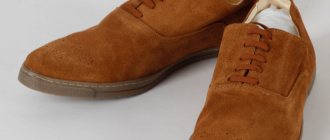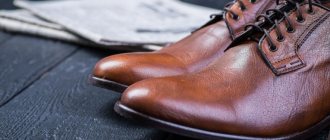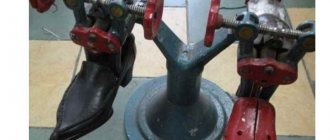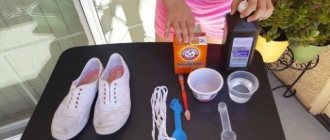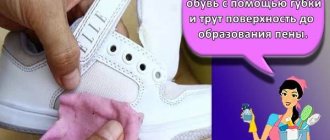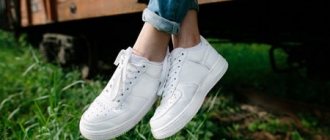Receive one of the most read articles by email once a day. Join us on Facebook and VKontakte.
Who doesn't want to own only quality things? But now the world is ruled by the mass market. And it is somewhat naive to expect quality from Zara sneakers like the latest Adidas collection. Although a reputable brand is by no means a guarantee of quality. If you notice that your sneakers or sneakers are starting to wear out on the backs, then don’t rush to get upset and save up for new ones. This common problem can be dealt with at home. This is what folk craftsmen advise.
The heel of a shoe is the first place to show signs of wear. Especially when it comes to sneakers or sneakers. And while the lining is being wiped from the inside, many ignore the alarm signal. But when the material begins to crack on the outside... To avoid it being too late, take action as soon as you notice the first “symptoms” (as in the photo). And this popular life hack will help you save your sneakers.
1. A fragment of fabric of a similar shade to the backdrop (it is best to use jeans due to its strength and wear resistance);
2. Glue for shoes;
3. Thick needle and thread.
General recommendations
When planning to restore sneakers, you need to take into account that different models differ in the materials used to make sports shoes. Depending on the material, the nuances of further repairs depend. The main task of the work is to update shoes and maintain proper appearance. Without going to a workshop, you can easily glue or extend the sole, whiten the visible part of the products, and eliminate small cracks.
The toe of a sneaker is most susceptible to wear and external influences, which is why tears most often form on it. The toe section is constantly in need of repair due to increased load, so the restoration of this element should be approached with great responsibility.
Even if worn and handled carefully, sneakers will wear out faster than other shoes, especially when used for sports. Prolongation of operation is facilitated by timely repairs and compliance with preventive care measures. This reduces costs compared to purchasing a new pair of sports shoes.
How sneakers are repaired inside
The speed and degree of wear are primarily influenced by materials: leather parts are more durable, fabric parts wear out faster. All internal gaskets and protectors must be replaced if deformed.
Repairing the heel counter of sneakers is a delicate internal operation. All parts of the restored pair are symmetrical - blanks and patterns for them require precise adjustment. If the backdrop is not completely replaced, then all worn out and deformed parts are removed before installing the elements.
The price of repair or replacement depends on the materials used, the degree of damage, and the complexity of restoring the exterior finish. Complex decorative elements increase the cost of work. The lining fabric must match the original one, or be completely replaced in the visible part of the shoe.
When repairing sneakers, materials similar to the original ones are used inside. This is important for maintaining sporting performance and durability.
To extend the life of new and refurbished sports shoes, you need to follow simple rules:
wear sneakers according to the season - the uppers and soles of winter models can withstand low temperatures, humidity and other difficult conditions;
put on and take off only completely unlaced, without creasing the back;
Noticing in time that the backs of your sneakers have worn out will make it easier to restore them.
DIY tread repair
The most vulnerable are the protectors located on the heels of shoes. To restore them, you will need a hard piece of rubber, which can be taken from the sole of unnecessary shoes. Among the tools and additional devices that will be useful for work are: shoe glue, a sharp knife, and coarse sandpaper. The tread repair process is as follows:
- A patch is cut out of a piece of hard rubber and fitted in place of the damaged or worn out tread.
- Using a knife and sandpaper, make a wedge-shaped patch.
- The surfaces that will be glued are treated with sandpaper to roughen them, and then wiped with a solvent and allowed to dry.
- The adhesive composition is applied in two layers to the patch and the future location of the protector. The drying time of the first layer should be about 20 minutes, the second - 4-6 hours.
- After the glue has dried, the surfaces are heated over the stove until a smell appears, applied to each other, squeezed tightly and held until cool and fixed.
How to repair heels
To repair heels on sneakers, you need to get rid of the old tread, tearing it off the sole, cutting it in places where it is impossible to separate the element manually. To simplify the task, you can treat problem areas with a solvent.
After removing the tread, the contour of the sole is transferred to thick paper or cardboard and the erased edges are completed. Having drawn the outline, the pattern is cut out of paper and used to create a new blank. You can make the sole from a rubber mat, which is sold in hardware stores. It is impractical to partially restore the sole, so if the heel of the sneakers is damaged, the base is completely changed.
When gluing the sole to the main part of a sports shoe, you need to thoroughly clean the surface. Otherwise, the gluing procedure does not differ from the standard one.
How to repair the top
The features of repairing the upper part of the sneakers directly depend on the material used. If shoes are made of suede, natural or artificial leather, then the material wears out over time and cracks at break points. To restore the appearance, patches made of thin and elastic material can be glued or sewn onto cracked and cracked areas. Before applying patches, the old material is torn off.
The use of patches on the upper part of the sneakers ruins the original appearance of the shoes, so it is better to prevent cracks from occurring. To maintain shoes in good condition, natural leather should be periodically lubricated with cream, and suede should be cleaned with a dry, stiff brush, trying to lift the pile. To clean the upper part of your sneakers from dirt, you should use a damp cloth rather than washing your shoes under running water.
Moleskin
You can take the additional steps above by using a self-adhesive material called Moleskin. It's designed to put you on your feet, but you can instead adjust it to your shoes for a more secure fit.
You may have to replace it from time to time, but it's inexpensive and has the added bonus of adding enough padding to make them more comfortable.
Sole
The quality and condition of the sole affects the comfort when wearing sports shoes. With prolonged use, the sole of the sneakers wears out and becomes deformed. Stepping on stones and unpaved surfaces risks damaging the sole, causing holes to form on it.
How to seal a hole
Any holes in the sole can be repaired in different ways, depending on the base material of the sneakers and the extent of the damage. Most often, epoxy glue is used to eliminate holes, which is relatively affordable and easy to use. Holes on the sole are sealed as follows:
- all edges of the hole are well cleaned and treated with a solvent to degrease;
- when the area next to the defect is completely dry, apply the diluted adhesive composition;
- if the hole in the sole of the sneaker is too large, a fiberglass mesh is placed in it to fill the void;
- when the glue dries, cover the damaged area from the outside with masking tape to level the sole;
- The sneakers are left in a well-ventilated area to dry completely.
How to increase worn out
If the soft sole of the sneakers has worn down slightly, it can be increased to its original thickness. For this purpose, you will need to purchase microporous rubber. A blank is cut out of the material in the shape of the worn-out element, the surface is cleaned with sandpaper and glued to the shoes.
It is better to use a special kind of shoe glue as glue to ensure reliable adhesion.
Replacement
A sole with a lot of damage is easier to replace with a new one. This will significantly reduce the time spent on repairing each damaged area. The replacement sole, as well as for extension, is cut out of microporous rubber. The sneaker is applied to the cardboard and the outline is outlined, and then it is transferred to the prepared material and the blank is cut out.
The advantage of using microporous rubber to create a new sole is the ability to cut parts into different shapes and sizes. The material can be used to make the sole of the desired type at minimal cost. In addition, microporous rubber has the following performance characteristics:
- light weight, strength and elasticity;
- resistance to rapid erasure;
- anti-slip;
- immunity to various atmospheric phenomena;
- no need for additional processing.
If you rub your heel in sneakers
Chafing heels are a fairly common symptom of recently purchased shoes. In order not to carry around a pack of adhesive plasters to cover abrasions, you need to solve the problem as soon as the problem arises. To do this, you can use the following tips:
- Special silicone stickers on the heels of shoes prevent the appearance of calluses;
- To soften hard heels, use a hammer to lightly tap the back of leather shoes from the inside;
- Place a towel soaked in warm water in the shoes and leave for 20-30 minutes. After this, apply pharmaceutical glycerin to the water-softened backdrops and leave until the morning. If this procedure does not help the first time, it is recommended to repeat it;
- If shoes have been left for a long time without proper care, the leather can dry out and rub the heels. To cope with this problem, you need to lubricate the back with baby cream, fat or soap and leave it overnight;
- If your sneakers are rubbing at the back due to the seam running along the heel, you should contact a shoe repair shop. The master will install a patch made of soft material in this place. In addition, the workshop offers a service for stretching shoes to length, which will also help achieve wearing comfort.
Combination top repair
On sneakers with a combined upper made of synthetic material with foam padding or natural and artificial suede, the fabric most often damaged is in the toe area, where the shoe comes into contact with the toes. On the outside, this area can be protected by a rubber insert around which there is a mesh, which is typical for running models of sneakers.
If there is minor damage to the front of the shoe, a patch can be sewn on. If there are large holes, you need to prop up the seams, adjust the size and shape of a piece of durable nylon fabric and sew it in place.
Your benefits when contacting us
A well-carried restoration increases the service life of shoes. The quality of our company’s work satisfies the most demanding customers. Our work schedule is also considered an important convenience for private and corporate clients: from 10 to 23 hours. The courier will pick up and deliver the order at a convenient time, and the wait does not last for hours.
For orders over 1990 rubles, our delivery within Moscow is free. It makes sense to order repairs and cleaning at the same time. If the order price is lower, then delivery will cost 290 rubles.
How to fix a backdrop
Damage to the back of sneakers manifests itself in different ways: the fabric tears, the inner lining comes out, and discomfort appears in the heel.
When repairing shoes at home, you can take the following steps:
- Carefully cut off the torn edges in the area where the lining is located.
- Select a piece of thin leather that is soft to the touch and cut the blank in the shape of a small horseshoe. This shape is required to cover the entire surface of the heel of the sneaker.
- Treat the leather blank with shoe glue, thoroughly covering the entire surface, especially the edges.
- Carefully apply the patch to the heel of the shoe and place any suitable size object inside the sneaker to spread and press the fabric tightly.
- Leave the shoes for several hours for the final fixation of the patch.
How to repair shoes at home: cold and hot method
Understanding the details of the question of how to repair a hole in a sole, anyone interested in common methods for solving the problem will notice two effective approaches to implementing the idea.
The cold method requires a minimum of skills in working with the material; before applying the mixture, the joints are cleaned, after which you will need to press the two parts tightly, liberally lubricating the crack of the boots with a fixing liquid.
The hot method will be relevant for working with too hard soles, the composition is applied to the damaged surface and heated with a hairdryer, even a cosmetic copy will do, you don’t have to look for a construction model.
It is important not to overheat the layer, otherwise it will lose its qualities; 30 seconds is often enough, but before performing manipulations you should read the instructions from the glue manufacturer.
Do-it-yourself sports shoe repair: sealing the sole of sneakers
There is no need to panic, thinking about how to repair your favorite thing that fits perfectly on your foot and does not restrict movement.
Sports models are exposed to stress every day, so when performing the method, you should be as careful as possible and complete all the steps efficiently, so that the first time you step on the treadmill or into the gym, the soles of your sneakers do not have to be repaired again.
Dirt and debris are completely cleared from the problem area, after which the surface should be degreased with solvent or white spirit. When working with large holes, the cracked sole will have to be pre-reinforced with fiberglass mesh.
Upon completion of these stages, you can proceed to filling the space; construction tape is glued over the layer of fixing liquid; it will make the outer side more even and prevent the mixture from spreading.
What shoe glue to use to seal a hole in a sneaker
When thinking about how to restore the model and how to seal the sole, it is important to give preference only to proven brands of fixing mixture, otherwise the result of the work will upset the master.
Among the products that are popular among professional shoemakers are the following product samples:
- EVA.
- Desmocol.
- Super Moment (second).
- Kenda Farben SAR 306.
To repair a cracked sole at home on sports sneakers, it is better not to skimp on buying glue, because the reliability and durability of the installed patch depends on this component of the repair.
How to repair a hole in the sole of winter boots
If you look at the element in cross-section, each craftsman will notice one important feature: in the structure of the component of seasonal shoes there are voids, similar to honeycombs, that need to be filled.
Without such additional actions it is impossible to talk about high-quality restoration; these places can be filled quite well with small pieces of rubber, after which the area can be filled with a fixing mixture of the most liquid form.
Often the insole also has to be changed; it simply gets pressed in, especially on the heel, and walking becomes very unpleasant. While waiting for complete polymerization, the item is placed under a press; if there is no vice, you can press the area with the leg of a table or cabinet.
Leather boots: how to restore a broken sole
Models of this type usually cost the owner a tidy sum, so people are in no hurry to throw them away, but rather wonder what to do and how to seal the problem area. Liquid leather copes well with the problem if the sole has cracked and touched the top layer of material.
You need to work with the product according to the instructions, and also devote sufficient time to leveling the applied layer.
The torn, cracked or burst area is coated with an ear stick; if necessary, you can use a thin brush to help; there is no need to rush, it is important to lubricate all sides, then press them tightly, leaving them under pressure for a certain time.
We repair the soles of rubber boots
In such models, you need to create a sealed and durable base, otherwise water will penetrate inside the product and your feet will get wet.
To achieve a better result, you can use step-by-step instructions that look like this:
- The surface is thoroughly cleaned of dirt and degreased with specialized compounds.
- A matte texture is created using fine sandpaper.
- Coat both parts with glue and wait 5 minutes.
- After time, another layer of the fixing mixture is applied and the gap is tightly compressed.
Most often, complete polymerization takes at least 24 hours; there is no need to check the reliability of the grip or disturb the boots so that the rubber sticks well to each other.
If you follow this sequence when repairing shoe soles, the item will last for many more years and will reliably protect the owner’s feet from moisture even in heavy rain.
How to restore the adhesive fastening of a sneaker using a patch
The process is quite painstaking, but even beginners who have seen the sole burst or the material come off for the first time can realize their plans.
To achieve a positive result, it is difficult to do without an overlay; this auxiliary element will fit onto the sole and the main frame of the sneaker, thereby creating a reliable connection between the two parts.
All areas are thoroughly wiped with acetone or white spirit; without degreasing, the glue will not be absorbed so well into the structure of the material, and adhesion between the planes will certainly suffer.
A lot depends on the strength of the initial compression; you need to squeeze the repair site very tightly, and then leave it in that position for several hours. Over time, the load will need to be reduced so as not to deform the model; sneakers can quickly bend and become uncomfortable during subsequent wear.
How to glue the soles of shoes
Women's models with high wedges are much more difficult to restore, but manipulation is still possible.
It is important not to spoil the appearance of the shoes with smudges or damage; all excess squeezed out mixture is wiped off in a timely manner before the composition sets and penetrates into the structure of the base material.
Accuracy at each stage will not hurt, initially the problem area is cleaned of dirt and dust, all kinds of threads or pieces of foam rubber are cut off with a sharp knife.
To fix a torn heel, you should buy glue based on rubber or polyurethane; such product samples are popular with professional shoemakers.
The adhesive is spread with a brush after degreasing the surfaces; after leveling the element, you need to place the model under pressure not exceeding the standard weight of a person so that the heel does not simply break from excessive load.
How to reduce the number of cracks
A common cause of cracks in sports shoes is improper use. In particular, defects appear on sneakers due to wearing shoes of a larger size, excessive bending of the foot while wearing, prolonged pressure, exposure to high or too low temperatures.
If you follow the rules for using shoes, cracks will appear on them in a minimal amount.
To reduce the number of damages, it is recommended to use special mold holders, blocks and spacers during storage. It will also be useful to stuff the sneakers with crumpled paper to flatten the shells. Another factor that leads to the formation of cracks is soiled shoes. When a large number of dirt particles accumulate, the number of cracks increases and they grow faster. For this reason, the products should be kept clean.
Elimination of cracks
Is it possible to repair the cracks that traditionally disfigure the folds that accompany the junction of the top and the foot (this phenomenon is inevitable over time for leather models)? It turns out that in order to repair these defects, you need to carefully trim the sole, bend it, and then seal the cracks with pieces of suede with the nap facing outward. In addition, it is permissible to eliminate defects with a leather patch.
As for cracks that make sneakers less presentable, some measures will help initially prevent or reduce their formation:
- keep your shoes clean, as dirt causes cracks to form;
- during storage (for example, in winter), fill the sneakers with paper, this will allow their body to flatten; it is also good to use special mold holders, spacers, and pads.
- wear styles that fit only (because if they are too big, cracks appear faster);
- Avoid excessive bending of the feet and prolonged pressure when walking.
How to properly care and wear
To extend the service life and maintain the proper appearance of your sneakers, you need to follow a number of simple rules. In particular:
- Take off and put on sneakers unlaced. If you do not untie the laces, the resistance on the heel will increase, which will cause its deformation.
- Only wear shoes that are the right size. Otherwise, abrasion will occur faster.
- Use the correct type of running shoes. For running, training and everyday life, appropriate types of shoes have been developed, so you should not limit yourself to one pair, but choose a separate option for each type of activity.
- Buy quality shoes. Attempts to save money often lead to accelerated wear and tear and the appearance of a large number of defects, as a result of which you have to constantly carry out restoration or throw away the sneakers.
Take off and put on sneakers only unlaced
Because of the rush, we don't untie our sneakers. At such moments, we overcome the resistance of the backdrop to take off our shoes. Think about it: the heel, which is designed to support our foot, resists our pressure every time. We win, but the heel of the sneaker loses and wears out faster.
On many sneakers, the lacing even goes along the instep of the foot. This helps avoid ankle injuries. In such cases, it is necessary not only to untie the laces, but also to loosen the lacing.
Why does the mesh wear out and tear?
The vulnerable and short-lived part of sports shoes that often wears out is the mesh. The causes of damage are as follows:
- Features of the legs . Some people's legs have structural features that differ from the standard ones. This could be a protruding toe, a bunion, or an atypical foot shape. Where the foot presses on the shoe more than necessary, the mesh breaks faster.
- Sloppy walking . Sometimes people move quickly, do not look at their feet, often stumble or hit one foot against the other when walking. These actions ultimately lead to damage to the shoes.
- Active lifestyle . Hiking, mountain climbing, and even long walks around the city can take a toll on your sneakers, causing them to quickly lose their appearance.
- Frequent washing . If the shoes are light, you have to clean them almost every day. To prevent regular exposure to brushes and detergents from damaging the mesh, you should use special soft rags, sprays or wet wipes, and it is better to completely wash your sneakers as rarely as possible.
- Accident . No one is immune from small incidents. If a person accidentally stumbles, hits or even touches the mesh with something, it can tear, especially if it is made of thin material.
- Weather . Rain, snow, dirt and other natural factors often negatively affect the condition of the fabric of sneakers. The mesh becomes thinner and wears out faster.
- Sports . Those who love to exercise need to be prepared for damage to their sneakers. Football, volleyball and even running wear out shoes more than walking. In this case, it is better to have a special pair for physical education.
On cheap shoes, the mesh breaks faster, but the high price also does not protect against the risk of damage.
Why does this happen?
- The most common option is poor quality shoes. If the materials from which the shoes were made are of very low quality, then the shoes will quickly wear out at all places where they are folded.
- Health. About 80% of the population have various types of foot deformities to one degree or another. In accordance with the characteristics of gait, overload zones appear in the areas of “shifts” of the pressure curve, and at a certain age, corns form. The skin of the outer edge of the heel, the forefoot, and the inner edge of the big toe are especially affected. This is where excessive shoe wear occurs. Most often, excessive shoe wear causes flat feet. With this disease, a person simply cannot place his foot correctly and evenly, as a result of which the shoes quickly lose their shape and wear out. The same goes for the heel. If the shoe itself is severely deformed, then the heel begins to wear out.
- Influence of type of activity. Many dancers who wear professional dance shoes complain that even expensive ballet shoes wear out quickly. The reason here is that dancers have too much mobility in their feet. Even when walking normally, they arch their foot, causing the heel to rub. But most often car drivers face this problem. When you constantly press the gas brake pedal, the heel rubs against the plastic. To avoid this, you just need to drive the car more carefully and watch where your foot is positioned on the pedals. If you can’t do this, then special “overlays” for shoes are sold for such cases. They are easy to put on any shoe. Made from a variety of materials and colors, this type of “shoe” for your shoes will protect them and extend their lifespan.
What to do if the mesh on your sneakers is frayed or torn
Even the best quality sneakers can tear or become damaged. To avoid throwing away a good pair of shoes, you should try to repair them yourself.
Sew with thread if a small area is torn
You need to take a thread that matches the color of the sneakers and a needle. A needle is inserted into the holes in the mesh and gradually pulls the material until the seam hides the torn area. You need to sew not along the edge of the hole, but a little further, capturing more fabric. This will prevent the shoes from tearing again when worn. When the seam is completed, you need to tie a tight knot and trim off the unnecessary part of the threads.
The seam should be small and tight. This way it will look neater and last longer.
General recommendations for use and care
To make your sneakers last longer and at the same time maintain their presentable appearance, you should use the following tips:
- Do not remove them laced. This puts a lot of stress on the backdrop and it will deform faster.
- Wear only your own size shoes. If you wear large or too small models, this will accelerate abrasion and the formation of other defects.
- Each type of activity uses its own type. After all, some models are designed specifically for jogging, others for the gym, and others are designed for everyday wear. Each has its own design features.
It is useful to know how to repair sneakers in simple ways that extend the life of your favorite pair, without calling a repairman, without using expensive materials - this will help save the family budget.
Return to list of publications

